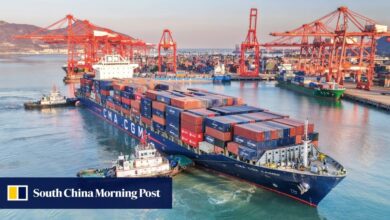Opinion | Post-pandemic global supply chain turmoil might still ruin Christmas

The disruption compounds supply chain challenges worldwide that have, since Covid-19, dramatically raised freight rates, forced changes in supply routes, and provided fuel to protectionist forces that are calling for “onshoring”, “near-shoring” and other “de-risking” measures.
There is still hope for Canada’s rail network. The government intervened last Thursday, ordering the unionists and Canada’s two main rail companies into arbitration. But the union has responded by calling for a 72-hour strike from Monday.
Even if Canada’s dispute is settled, International Longshoremen’s Association members’ strikes might shut down 36 US east and Gulf coast ports in October.
It shouldn’t be surprising that maritime freight rates have recently risen to record levels – around US$5,900 per 40-foot container in July, compared with $1,342 last October. Nor that US importers are already moving goods way ahead of the annual Christmas shopping rush.
The North American rail and port woes only add to a long list of unprecedented challenges facing global shippers. On top of the well-documented strain on global supply chains during Covid-19, Russia’s invasion of Ukraine has forced profound and perhaps permanent shifts in global goods flows.
Much of Europe’s oil and gas no longer flows from Russia, but instead is being brought in from North America and the Middle East. New sources of grain and fertiliser have been sought to replace traditional supply routes from Ukraine and the Black Sea region.
Not only is the Cape route some 3,000 nautical miles or around seven days longer from Asia to Europe (for example, Shanghai to Rotterdam is 10,600 nautical miles or 27 days via the Suez route, but 13,800 nautical miles or 35 days via the Cape), but ships normally travel faster to make up for lost time, burning more fuel and emitting more carbon dioxide.
Most severely hit are exporters from Djibouti, Sudan and Saudi Arabia, which in the past shipped 31 per cent, 34 per cent and 26 per cent respectively of their goods via the Suez Canal.
Climate change has also, and unexpectedly, put in jeopardy the future of the world’s other critical piece of maritime infrastructure – the Panama Canal. A collapse in seasonal rainfall has starved the Gatun Lake, which regulates the water level along the canal, making it impassable for the world’s newest and largest ocean-going vessels. Recent rain has relieved some pressure, but the canal’s daily transits are still significantly down.
A recognition that climate-related changes may permanently alter the canal’s carrying capacity has forced shippers to consider long-term alternatives. Worst impacted are Ecuador, which relies on the canal for 26 per cent of its exports, and Peru and Chile (both 22 per cent).
Perhaps most unhelpful of all is the trade war being waged on China by the US since 2018. Then president Donald Trump’s efforts to cut the US trade deficit with China, and reduce American reliance on China for a wide range of goods deemed essential to national security, has altered – perhaps permanently – the shape of supply chains worldwide.
While Trump’s war was maybe aimed overall at “deglobalisation”, a recent study by Oxford Economics suggests that there is as yet little concrete evidence of any overall contraction of trade.
Instead, we may be seeing an increase in “south-south” trade and a diversification of China’s trade away from the traditionally dominant wealthy markets of North America. After all, supply chains link emerging groupings like the Regional Comprehensive Economic Partnership, Brics and the Shanghai Cooperation Organisation.
It seems the turmoil in global supply chains is unlikely to quieten any time soon. But the turmoil will focus not on a decline in global trade, but on who the supply chains will link, and how.
David Dodwell is CEO of the trade policy and international relations consultancy Strategic Access, focused on developments and challenges facing the Asia-Pacific
Source link




